Prices in AUD. Shipping worldwide. Flat rate $8 postage per order within Australia. International by weight calculated at checkout. Read full terms.
-
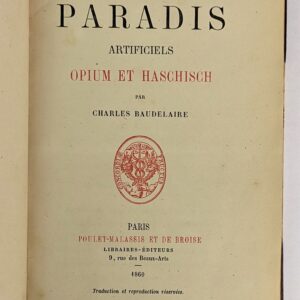
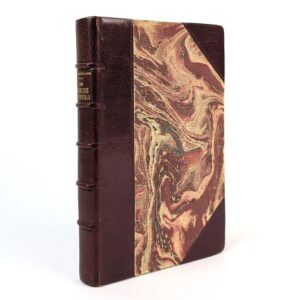
Les Paradis Artificiels: Opium et Haschisch
AU$4,000.00 Read MoreAdd to cartCharles Baudelaire
Paris: Poulet-Malassis et de Broise, 1860.First edition of Baudelaire’s Artificial Paradises, on the drug experiences of hashish and opium and their relationship with creative expression, being accounts from within the walls of Le Club des Haschischins and a translation and adaptation of Thomas De Quincey’s Confessions of an English Opium-Eater. CARTERET I:126. This copy rebound in a fine half leather binding without the wrappers.
-
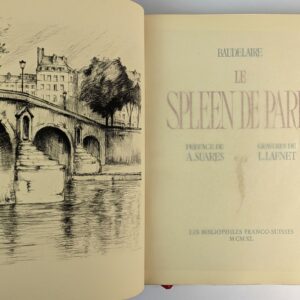
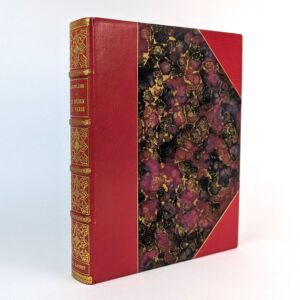
Le Spleen de Paris
AU$1,400.00 Read MoreAdd to cartCharles Baudelaire; L. Lafnet
: Les Bibliophiles Franco-Suisses, 1940 [1941].One of 106 numbered copies reserved for members of the final illustrated book by Luc Lafnet, with 90 etchings each with tissue guard.
-
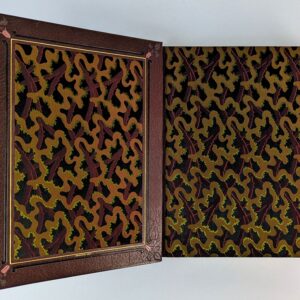
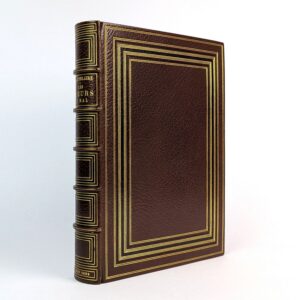
Les Fleurs du Mal
AU$9,000.00 Read MoreAdd to cartCharles Baudelaire; Armand Rassenfosse; Henri Noulhac
Paris: Les Cent Bibliophiles, 1899.One of 115 numbered copies of the first, and widely considered the best, illustrated edition of The Flowers of Evil, being the chef d’oeuvre of Belgian artist Armand Rassenfosse, with nearly every page of the text illustrated with Symbolist colour etchings and nude women. This copy from the collection of actor and bibliophile Barry Humphries, with his bookplate; bound in a fine binding signed Noulhac 1918, with multi-rule borders and silk doublures framed with inlaid leather strips and flowers at the corners. Illustrated with a portrait frontispiece, throughout with hundreds of colour illustrations and tailpieces, as well as 6 plates and a page of text with tailpiece outside of the text. Bound at the rear is a Juin 1897 Specimen being the leaf of XX La Geante with an alternative tailpiece illustration and the chapter plate for Les Fleurs du Mal, an etched menu cover for a Les Cent Bibliophiles Dinner for Fleurs du Mal, 6 Mai 1901 by Rassenfosse, as well as 17 additional etchings by Evert van Muyden and other artists.
-
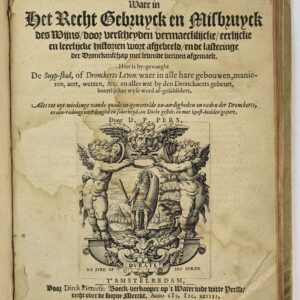
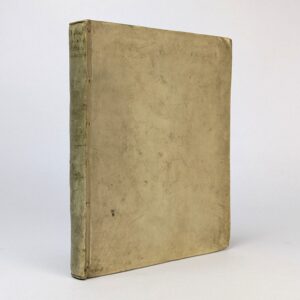
Bacchus Wonder-wercken
AU$1,400.00 Read MoreAdd to cartD. P. Pers
T’Amstelredam: Dirck Pietersz, 1628.Waer in Het Recht Gebruyck en Misbruyck des Wijns, door verscheyden vermaeckelijcke eerlijcke en leerlijcke historien wort afgebeeld, ende lasteringe der Dronckenschap met levende verwen afgemaelt. Hier is by-gevoeght De Suyp-stad, of Dronckerts Leven: waer in alle hare gebouwen, manieren, aert, wetten &c. en alles wat by den Dronckaerts gebeurt, boertlijcker wyse word af-geschildert… /[Bacchus Wonder-works: Which in The Lawful Use and Misuse of Wine, by various entertaining honest and instructive history is depicted, and the blasphemies of Drunkenness are painted with living pains. Here is by-joined The Suyp-town, or Dronckert’s Life: where in all her buildings, manners, aert, laws &c. and everything that happens by the Dronckaerts is painted off …] Dutch work on wine by the bookseller Dirch Pieters Wittepers, illustrated with title vignette and 4 engravings by Gillis van Scheyndel in the text. Another work on The Hague, ‘s Graven-Hage, by Jacob vander Does (1668) without the title page or engravings bound before it.
-
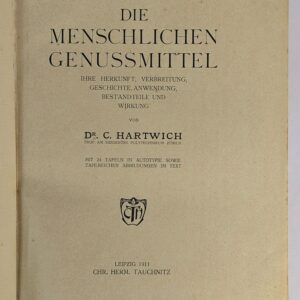
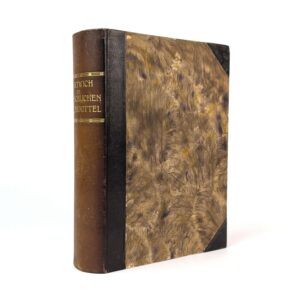
Die Menschlichen Genussmittel
AU$350.00 Read MoreAdd to cartC. Hartwich
Leipzig: Chr. Herm. Tauchnitz, 1911.[Human Stimulants: Their Origin, Distribution, History, Use, Components and Effects.] Monumental encyclopedia of ethnopharmacology by German pharmacist Carl Hartwich (1851-1917) based on anthropological and ethnological studies from remote sources.
-
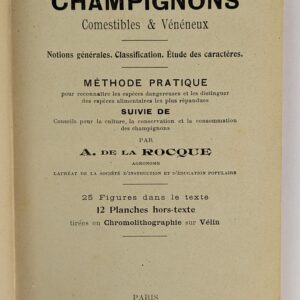
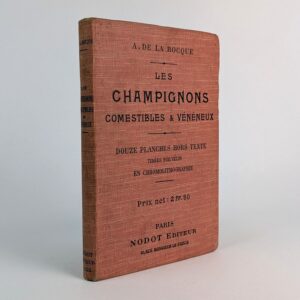
Les Champignons Comestibles & Veneneux
AU$100.00 Read MoreAdd to cartA. de La Rocque
Paris: Nodot Editeur, No date.Edible and Poisonous Mushrooms: General Notions. Classification. Study of Characteristics.
-
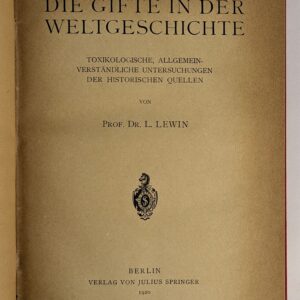
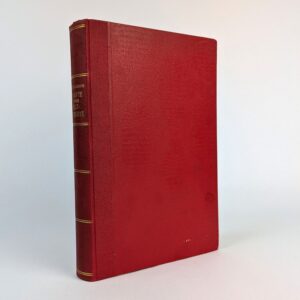
Die Gifte in der Weltgeschichte: Toxikologische, Allgemein-verstandliche Untersuchungen der Historischen Quellen
AU$250.00 Read MoreAdd to cartL. Lewin
Berlin: Julius Springer, 1920.First edition of German pharmacologist Louis Lewin’s (1850-1929) important contribution to the history of medicine being a history of poisonings with innumerable citations from ancient and modern literature.
-
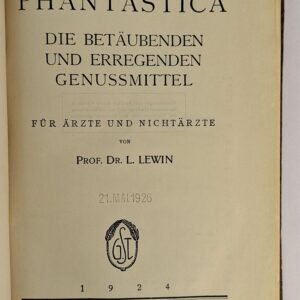
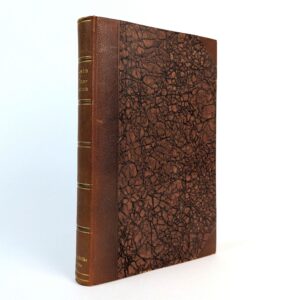
Phantastica: Die Betaubenden und Erregenden Genussmittel
AU$800.00 Read MoreAdd to cartL. Lewin
Berlin: Georg Stilke, 1924.First edition of the psychedelic classic by German pharmacologist Louis Lewin (1850-1929). Set the standard for the classification of psychoactive drugs: Inebriantia (Inebriants such as alcohol or ether), Excitantia (Stimulants such as Khat or Amphetamine), Euphorica (Euphoriants and Narcotics such as Heroin), Hypnotica (Tranquilizers such as Kava), Phantastica (Hallucinogens or Entheogens such as Peyote or Ayahuasca). Later translated into French, Italian, and English, the 1931 English edition said to be Aldous Huxley’s introduction to drug literature.
-
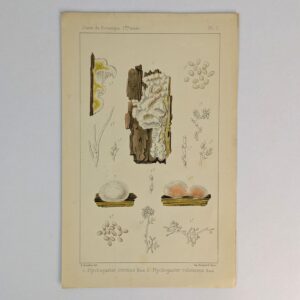

Description de Deux Nouvelles Especes de Ptychogaster et nouvelle preuve de l’identite de ce genre avec les Polyporus
AU$80.00 Read MoreAdd to cartM. Boudier
Paris: J. Mersch, 1887.Description of Two New Species of Ptychogaster and New Evidence for the Identity of This Genus with Polyporus. Extract from the Journal de Botanique 15 February, 1887. This copy inscribed by Boudier.
-
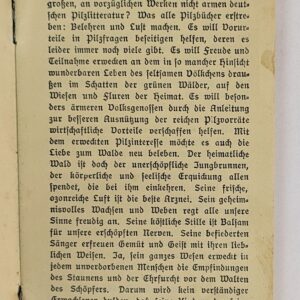

Ungeniessbare Pilze
AU$200.00 Read MoreAdd to cartPaul Schneider
Dresden: Rudolph’sche Verlagsbuchhandlung, 1925.Inedible Mushrooms: The most important and most common inedible and poisonous mushrooms as a warning for all mushroom hunters, presented in 48 color art prints with accompanying text. Scarce German mushroom guide book, 3 copies recorded in OCLC, none outside of Germany.
-
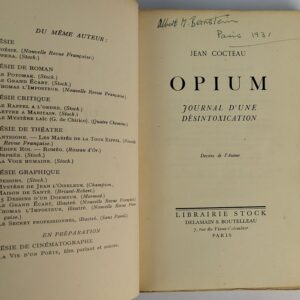

Opium: Journal d’une Desintoxication
AU$100.00 Read MoreAdd to cartJean Cocteau
Paris: Librairie Stock, 1930.An unnumbered copy of the first edition on paper.
-
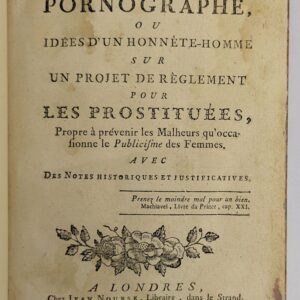

Le Pornographe, ou Idees d’un Honnete-Homme sur, un Projet de Reglement pour les Prostitutes,
AU$1,000.00 Read MoreAdd to cart[Nicolas Restif de La Bretonne]
Londres and La Haie: Jean Nourse and Gosse Junior, 1770.Propre a prevenir les Malheurs qu’occafionne le Publicisme des Femmes. Avec Des Notes Historiques et Justificatives. [The Pornographer, or Ideas of an Honest Man on a Draft Regulation for Prostitutes, Proper to Prevent the Misfortunes Occurring from the Publicity of Women. With Historical and Justificatory Notes]. Second Edition of the classic 18th century utopian text on sex work in which Bretonne envisions prostitution as a public institution with numerous social and medical benefits. This copy in a likely 20th century rebind in quarter leather with new endpapers, and extra-illustrated with one erotic illustration bound in at page 16.
-
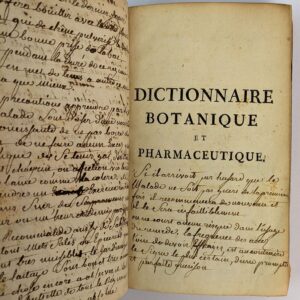

Dictionnaire Botanique et Pharmaceutique,
AU$200.00 Read MoreAdd to cart[Nicolas Alexandre]
Paris: Du Fonds de la Veuve Leconte, 1759.Botanical and Pharmaceutical Dictionary containing the Principal Properties of Minerals, Plants, and Animals of use with the most used internal and external Pharmacy Preparations in Medicine, & in Surgery. All taken from the best Authors, especially the Moderns. Useful work for young Pharmacists & Surgeons, Hospitals, Communities, & charitable People who dress the Poor. Mid-eighteenth century edition of the portable medical dictionary attributed to the Benedictine Nicolas Alexandre (1654-1728). 24 editions appeared from 1716 to 1846.
-
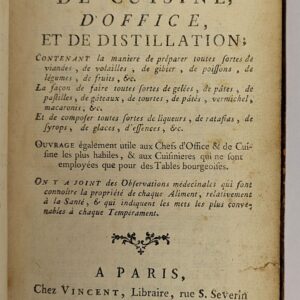
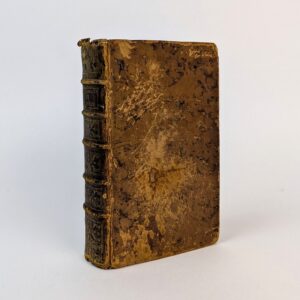
Dictionnaire Portatif de Cuisine, d’Office, et de Distillation;
AU$300.00 Read MoreAdd to cartAnonymous
Paris: Chez Vincent, 1767.Portable dictionary of cooking, office, and distillation: containing the manner of preparing all kinds of meats, veal, game, fish, vegetables, fruits, etc.: the manner of making all kinds of jellies, pastes .. : and of composing all kinds of liqueurs .. : work equally useful to the most skilled office and kitchen chefs .. : medical observations have been added which make known the property of each food, relative to health, and which indicate the foods most suitable for each temparment.
-
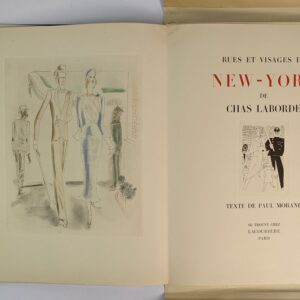
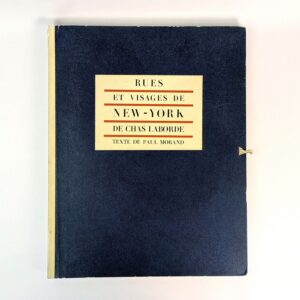
Rues et Visages de New-York
AU$2,200.00 Read MoreAdd to cartChas Laborde; Paul Morand
Paris: Lacouriere, 1950.Streets and Faces of New York. The final, and posthumous, of Charles Laborde’s series of works on famous world cities, having previously produced similar volumes on Paris (1926), London (1928), Berlin (1930), and Moscow (1935). The New York volume produced from sketchbooks he made on his trip in 1932, containing 15 accompanied by text by Paul Morand. One of 200 numbered copies on Arches from a total edition of 230.
-
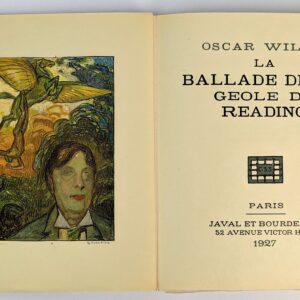
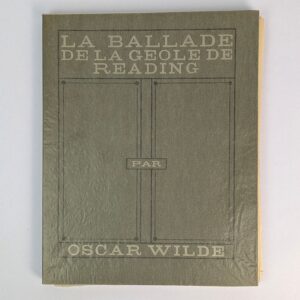
La Ballade de la Geole de Reading
AU$1,000.00 Read MoreAdd to cartOscar Wilde; G. Cornelius
Paris: Javal et Bourdeaux, 1927.French edition of Wilde’s The Ballad of Reading Gaol illustrated with 15 coloured copper engravings by Jean-Georges Cornelius. One of 225 numbered copies.
-
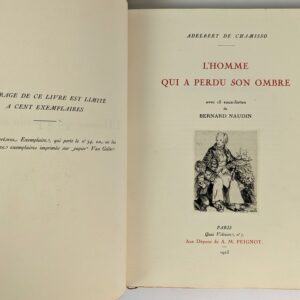
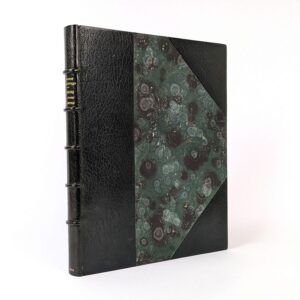
L’Homme qui a perdu son Ombre
AU$1,200.00 Read MoreAdd to cartAdelbert de Chamisso; Bernard Naudin
Paris: A. M. Peignot, 1913.French translation from the original German of Peter Schlemihls wundersame Geschichte (English: The Man with No Shadow) by the exiled French aristocrat, poet, and botanist, Adelbert von Chamisso (1781-1838). The story follows Peter Schlemihl who sells his shadow to the Devil for infinite money. The first edition with 15 engravings by French artist Bernard Naudin (1876-1946) limited to 100 numbered copies, this being one of 75 copies on Van Gelder paper, in a signed fine binding by Bernasconi with the original wrappers bound in. Peter Schlemihl was Naudin’s first major project after giving up painting to devote himself exclusively to printmaking.
-
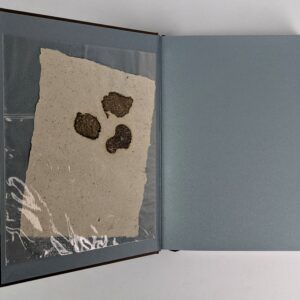
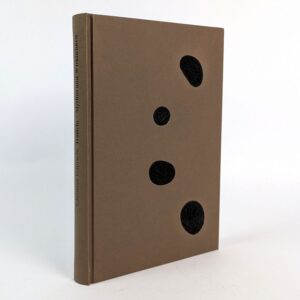
Truffeln: Mythos und Wirklichkeit
AU$400.00 Read MoreAdd to cartChristian Volbracht
Wiesbaden: Tre Torri Verlag, 2012.Truffles: Myth and Reality. The deluxe edition of 100 signed and numbered copies bound in papered boards with a truffle design of inlayed leather each with a sheet of handmade paper made from mushrooms with truffle slices.
-
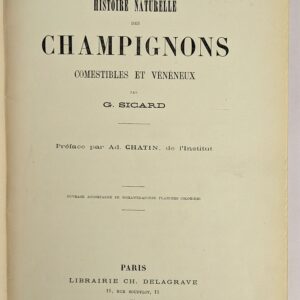
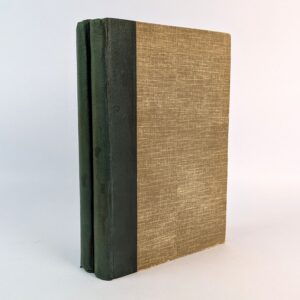
Histoire Naturelle des Champignons Comestibles et Veneneux
AU$1,000.00 Read MoreAdd to cartG. Sicard
Paris: Librairie Ch. Delagrave, 1883.Natural History of Edible and Poisonous Mushrooms by Guilleaume Sicard. Rebound in plain cloth with the plates in a second volume. VOLBRACHT 1981.
-
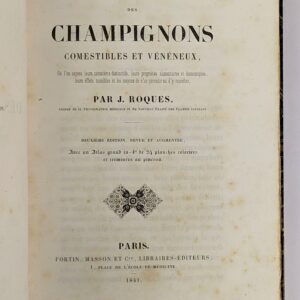
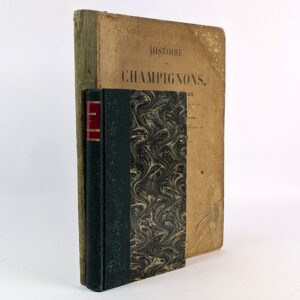
Histoire des Champignons, Comestibles et Veneneux, .. Avec un Atlas
AU$1,800.00 Read MoreAdd to cartJoseph Roques
Paris: Chez Fortin, Masson et Cie, 1841.[History of edible and poisonous mushrooms, decorated with colored figures representing the main species in their natural dimensions; where we expose their distinctive characteristics, their nutritional and economic properties, their harmful effects and the means of guaranteeing or remedying them, a useful work for mushroom lovers, doctors, naturalists, rural owners, mayors of cities and countryside, etc.] The second edition of one of the most important (and beautifully illustrated) early works on edible wild mushrooms and fungi in France. VOLBRACHT 1793.2. The atlas with 3 additional colour plates (1 folding) from two other works bound in at the beginning.
